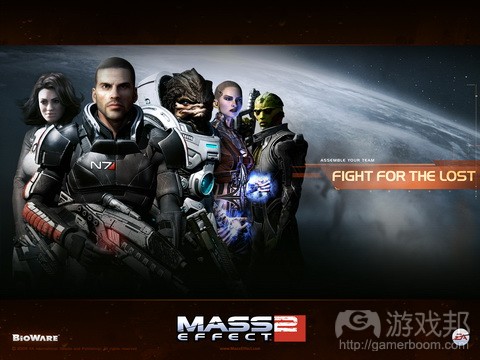解析BioWare游戏的对比并置机制
作者:Patrick Miller
BioWare的动画指导Jonathan Perry在2012 GDC中引入了“对比并置”概念,并引用了《瘪四与大头蛋》(游戏邦注:一个在1993年到1997年间,于美国知名音乐节目有线电视网MTV上播出的卡通影片系列)中大头蛋的话进行阐述:
“瘪四,如果他们的歌中没有糟糕的一段,那么其他部分也就不会显得如此动人。”
Perry从《质量效应2》的介绍序列开始自己的论述,这里指挥官薛普为了拯救“诺曼底号”而英勇牺牲,这就是一种“对比并置”的表现。Perry说道:“这个场景真的让我非常激动,一部分原因是我失去了我的角色,但同时也是因为场景本身所体现出的对比效果。”
“对比”是大范围内的动画技巧,包括诺曼底号爆炸时的鲜明视听对比效果,如巨大爆破声音和紧张画面,以及指挥官薛普咽下最后一口气,最终消失时逐渐暗淡的色彩和可怕的沉寂。
对比并置:对立性和语境关系
Perry解释道,对比并置的第一个核心元素便是对立性。“我喜欢基于对立角度思考对比问题。我们熟悉许多正面&负面对立元素,包括善与恶,明与暗等。但是却不一定达到两个极端。对立性让我们能够明确角色在一段时间后有何变化,即是否在对立中发生转换。游戏玩家总是希望受某种元素驱动而发生改变。”《质量效应2》中的Paragon/Renegade(善或恶)系统便是最显著的例子。
对比并置的第二大关键要素便是游戏各种对立关系的呈现情境。Perry以Alfred Hitchcock(游戏邦注:英国著名导演)的观点为例,即观众对角色的看法会受到一些核心画面的操纵。
Hitchcock首先描述了一位表情正常的老人,然后切换到正在逗婴儿的年轻女性,而后再跳到微笑的老人,此时观众会觉得这是一位“善良的老人”;但是如果第二个画面是位穿着比基尼的年轻女性,那么老人的形象就会变成“色鬼”。
Perry说道:“我们在很多BioWare游戏中都利用这一元素,即让玩家决定游戏所转换的画面。我们可以通过操纵事件顺序或语境关系创造或加强某些内容的意义(本来所没有的)。”
基于创意并置创建故事
Perry罗列促使BioWare围绕创意并置创建故事的几大创意过程要素:“首先,我们必须确定游戏主题。游戏能够传达何种内容?我们想要阐述何种故事?等等。虽然这么做并不轻松,但是我们都必须尽早明确这些内容,因为它们将影响我们的所有设计决策。一旦你创造了主要玩家角色,你需要说明每一方的角色代表的是什么?就像在《质量效应》中,人类代表纯真、自由意识和混乱,而相对应的Reapers则代表权利、决定论和命令。”
基于这种对立性,Perry向观众呈现了《质量效应3》的预告片:“这是关于一个小男孩在玩玩具船的画面,但是却不只有这些内容。他是我们在《质量效应》世界中唯一能够看到的小孩。我们设置这个男孩以代表人类。所以他是年轻与纯真的象征。然后我们进入薛普的视角,发现她微笑了,因为她喜欢人类,她希望自己能够保护人类。所以这个小男孩便是你在游戏中的最终奋斗目标。”
对立性同样也包含在游戏的对话机制中。Perry指出他们重新编写了传统的《质量效应》对话选择,让玩家无法在《质量效应3》中避开复杂抉择。他说道:“我们不再让玩家保持中立态度,等着别人给出答案。我们希望玩家真正置身复杂的选择中,在此做出决策。”
Perry还阐述BioWare如何使用叙述地图表——从根本来说,就是在促使玩家做出重要的事件发展过程中,正弦波在Y轴Paragon(善)与Renegade(恶)间起伏波动。波线上的任何一点都预示着玩家同此善意决策或恶意决策达成共鸣。而当事件结束后,玩家就必须就两条完全不同的诱人道路并做出选择。
最后Perry还提醒道,无论是通过动画技巧还是基于游戏设计,创建对比关系并不等同于总是以极限状态呈现此关系:“你并不是将其调至11级,然后就置之不理。你要知道,是对比关系真正在吸引人们的眼球,所以你得明确所要强调的故事元素。如果这是你所认为的关键时刻,你要如何凸显它?或者怎么做才能让对比关系更加鲜明?”(本文为游戏邦/gamerboom.com编译,拒绝任何不保留版权的转载,如需转载请联系:游戏邦)
GDC 2012: ‘Contrastive juxtaposition’ is BioWare’s key to telling engaging stories
by Patrick Miller
BioWare cinematic lead Jonathan Perry introduced the concept of “contrastive juxtaposition” in a GDC 2012 talk on Thursday, summed up most succinctly by Butthead from Beavis and Butthead, of all people:
“Well, Beavis, if they didn’t have a part of the song that sucked, then like, the other part wouldn’t be as cool.”
Perry began by showing the introduction sequence from Mass Effect 2, in which Commander Shepard dies saving the crew of the Normandy, as an example of contrastive juxtaposition. “This scene was a really powerful and emotional moment for me in the game, partially because I lost a character but also because of the contrast in the scene itself,” Perry said.
“Contrast” referred to an entire range of cinematic techniques, including the sharp audiovisual contrast between the loud, bright explosions and jittery camera while the Normandy explodes to the muted color and eerie silence as Commander Shepard loses oxygen and eventually vanishes.
Contrastive juxtaposition: Polarity and context
The first central element of contrastive juxtaposition is polarity, Perry explained. “I like to think of contrast in terms of polarity. We have positive and negative polarities that we’re all familiar with–good vs. evil, light vs. dark. But they don’t have to be good and evil–up and down, for example,” Perry said. “Polarity lets us see how a character is changing over the course of a story, shifting in polarities over time. As players in a game, we like to be the one that’s driving that change.” Mass Effect 2′s Paragon/Renegade system is perhaps the most obvious example.
The second key element is the context within which the game’s various polarized relationships are depicted. Perry presented an explanation from Alfred Hitchcock about how an audience’s opinion of a character can be manipulated with a few key images.
Hitchcock’s example depicted an older man with a neutral expression, then a clip of a young woman playing with a baby, then back to a shot of the older man smiling, which gave the audience a “kind old man” character, but when the second shot was swapped out with one of a young woman in a bikini, the old man became a “dirty old man.”
“We do this a lot in BioWare games, and the image we swap out is determined by your decisions as a player. We can manipulate the order, the context of events to enhance meaning or create meaning where it would not have been otherwise,” Perry said.
Building a story around creative juxtaposition
Perry identified a few key elements in the creative process that lets BioWare build their story around creative juxtaposition. “First, we try to identify the theme of the game. What do we want it to mean? What story do we want to tell? This can be hard, but it’s important to establish them early because they can influence design decisions down the line,” Perry said, “Once you’ve established the major players, what does each side represent? In Mass Effect, humans represent innocence, free will, and chaos, against the Reapers’ authority, determinism, and order.”
With those polarities in mind, Perry walked the audience through a Mass Effect 3 trailer: “This is a boy playing with a toy ship, but it’s more than that. It’s the only child we’ve seen in the Mass Effect universe. We want this boy to represent humanity. He’s young and innocent. Then we come to Shepard watching, and she smiles. She loves humanity. She wants to protect it. This boy represents everything you’re fighting for in the game.”
Polarity played into the actual conversation game mechanic, too. Perry noted that the traditional Mass Effect dialogue options had been reworked to give the player fewer opportunities to shy away from hard choices in Mass Effect 3. “We’re not going to let you sit on the fence and let someone figure out for you,” Perry said, “We want to give you a hard choice. We want you to choose between shades of gray.”
Perry explained how BioWare used a narrative map graph–essentially a sine wave fluctuating between Paragon and Renegade on the Y axis over the course of a sequence of events leading to a significant game decision. Each point along the wave denoted a moment in the sequence where the player would be led to sympathize with the Paragon or Renegade decision. By the time the event concluded, the player would be forced to choose between two genuinely compelling paths.
But Perry cautioned that establishing contrast, whether through cinematic techniques or game design, wasn’t about going full bore all the time: “You can’t necessarily crank it up to 11 and leave it. It’s the contrast that grabs your attention. And to do that, you need to identify the story elements that you want to highlight. If that’s your key moment, how do you make it stand out? How do you make the lows lower and the highs higher?” (source:GAMASUTRA)








































 闽公网安备35020302001549号
闽公网安备35020302001549号